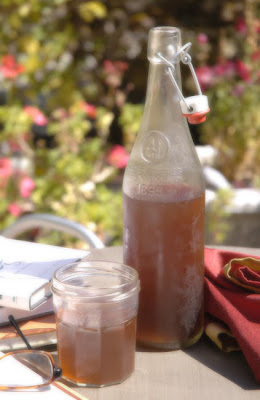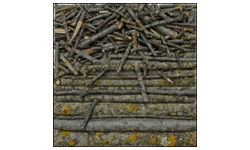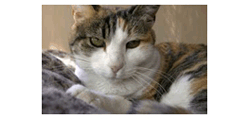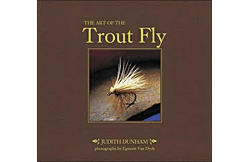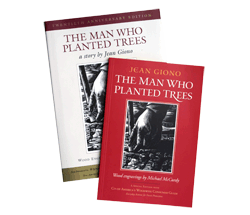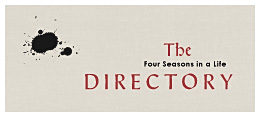The work progresses with my usual slow steadiness, methodically analyzing a variety of possibilities and after careful consideration, cautiously progressing to stage three. The canvases have started to reveal a direction in which each one desires to be taken and what is to happen next. From this point on, no canvas will receive the same treatment, especially the 16 x 16 inch canvas, since it saw only one new addition, a single tree. An image I immediately fell in love with and when one considers some of the concepts that were being previously contemplated, this illustration of a tree was perfect for a pastoral scene. The use of this print also would mean the canvases fate was being sealed early on and any additional layers of newsprint for a deeper distressed look was no longer possible.
The elements that are retained so far help bring together the direction this painting is heading, not only because of the solitary tree, but also because of the title ‘Pepper Spray Times’ and the word that has been mostly sanded down, but still visible ‘Community’. The placement of these three elements has been most deliberate, allowing for what is to be painted and where to balance out the composition, considering the painting when finished will be placed behind an old wooden window frame.
Untitled
Newsprint on canvas, 16 x 16” (40.64 x 40.64 cm)
Stage 3, layer five of newsprint after sanding
The idea of combining an image with a window frame is nothing new. When visiting Santa Cruz, we stopped in at a local gallery where we saw a photographer using an old window frames to place his photographic images onto the glass of a distressed window. However I did not care for the image to be placed upon the glass, rather I would want it to be behind and not even against the glass, rather give the illusion of looking to the outside onto something of interest.
My first inclination had been to create an abstract but what can a derelict window have in common with an abstract? The two seemed foreign, considering what I desired to visually express. In the end I settled on the idea of a pastoral scene with a songbird resting on a branch, especially after finding a wooden window frame, which had all the right qualities and reflected the passages of time.
Untitled
Newsprint on canvas, 16 x 16” (40.64 x 40.64 cm)
Close Up
Originally I had planned to stain portions of the newsprint surface with Kusmi tea from Kousmichoff to achieve the antique parchment look, but because the newsprint was adhered to the canvas with a thinned solution of medium gel, this was no longer possible. The use of the medium gel had also sealed the surface and though I could sand away the layer with very fine grit sandpaper, I would run the risk of altering the current look. After having achieved the desired distressed effect, I will just have to do without the Kousmichoff stain and so the surface was permanently sealed with gloss medium varnish.
Untitled
Newsprint on canvas, 12 x 12” (30.48 x 30.48 cm)
Stage 3, layers four-five of newsprint after sanding
After sanding the last application of newsprint, the smallest of the three canvases required a specific newsprint that we only receive once a week, when the supermarkets release their grocery advertisements. Since the first layer of newsprint had contained the store header, the direction this canvas would take was set early on.
The week before I had seen a pumpkin patch and the idyllic scene had started to influence my thoughts, but I am keeping my options open. I have considered the possibility of painting a cluster of walnut on a tree or a beautiful Bartlett pear with a touch of autumn colour. But first I will have to add one to two layers of newsprint featuring produce items and only after distressing the new layers could I determining what occurs next.
Untitled
Newsprint on canvas, 12 x 12” (30.48 x 30.48 cm)
Stage 4, layers six of newsprint before sanding
Previously I mentioned one would need to cover the entire surface with gel medium after one had glued into place the desired pieces of newsprint, but as I quickly discovered, this also meant one would have to first remove this layer with coarse sandpaper in order to reach the newsprint one was trying to distress and blend. Therefore the recommendation was to thin the gel medium with water so that it would still have ample adherence strength, but one would gain greater control in the sanding process.
After a selection of carefully chosen new images of seasonal produce which were cut to size and temporarily placed on the canvas to make sure the items would enhance the over all composition and appearance of the canvas. For it was important to distribute not only the right image but also a bit of colour.
When it became time to glue down the pieces of newsprint, I noted that by giving the paper a slight mist of water on its backside had added in the adhesion process. The paper became also more delicate to handle and if not careful could rip, however this could be turned into an advantage as another way to distress. Remember different grades of sandpaper is not your only option of distressing, using a small sponge, ones finger or a small tool to work the paper when it is wet allows for different kinds of damage and sandpaper is really the tool that blends the multiple layers.
Untitled
Newsprint on canvas, 12 x 12” (30.48 x 30.48 cm)
Stage 4, layers six of newsprint after sanding
Though sanding is a key component in the distressing process, keep looking for other ways to emulate surfaces you have seen and contemplate how you might go about achieving that particular look. What I am representing here should only be considered a starting point and that you should experiment, beginning with the different kinds of paper materials that are available to us.
There are shopping bag, cardboard boxes, corrugated paper, rice paper, recycled hand made paper, tissue paper made from mulberry fibers, and the list goes on and on. What matters is what you the artist are trying to achieve and express with the finished artwork. What you have so far seen is that each canvas started out the same way but after a few layers, each one began revealing a direction it would like me to venture.
Untitled
Newsprint on canvas with tissue paper, 12 x 12” (30.48 x 30.48 cm)
Stage 5, layer one of tissue paper before sanding
In order to tone down the various grocery newsprint advertisements and still permit it to be part of the painting, I decided to add a single layer of white mulberry tissue paper. This single layer would also provide a unified appearance to the entire surface of the canvas, but after the application of tissue paper had dried, I felt it did not have enough of a transparency that I was after. Therefore I decided to begin sanding the tissue paper with 150 fine grit sandpaper, carefully working the surface as to only reveal the subsurface textures, all the time keeping in mind what I might be painting.
Untitled
Newsprint on canvas with tissue paper, 12 x 12” (30.48 x 30.48 cm)
Stage 5, layer one of tissue paper after sanding
As you can see a compromised transparency was achieved but I also had lost the mulberry fibers that laced the tissue paper throughout and though this unplanned segment ended up being a compromise, I also discovered that tissue paper was far more durable than newsprint. By having sanded the paper considerable down with even pressure, the surface ended up being extremely smooth and because this was a single solid layer of paper, it provided an even surface which also strengthening all the layers beneath it into a solid bond.
Untitled
Newsprint on canvas with tissue paper, 12 x 12” (30.48 x 30.48 cm)
Close-Up
Sanding is only a portion of achieving the desired results that one is after. The selection and placement of the newsprint or different kinds of paper determines the look and direction of your distressed surface. You are ultimately in control of every aspect of the process; so let you imagination take on wings so it may soar.
While being engaged on these three canvases, I also discovered that there is an advantage to working multiple canvases. I was now able to try out different ideas between them and have the results be immediate, with the possibility to having an effect applied to another canvas while the canvas is still at the foundation building stage.
Untitled — in progress
Newsprint on canvas, 20 x 20” (50.80 x 50.80 cm)
Stage 2, layer four-five of newsprint after sanding
As each canvas began revealing a direction, this one was no different. Though it was clear more layers of newsprint were necessary, there were a few areas I felt were finished, particularly the upper right hand area and the large red lettering announcing a ‘sale’. These areas and the portrait of an African American man would need to be protected while working on adding a couple more layers and distressing between each application. We must also not forget that after the new pieces of newsprint had been added and sanded to their desired effect, it needs to be sealed before the next application of newsprint with gloss medium varnish. This would ensure that what had been accomplished previously would not be at risk of being lost while sanding around the area and blending the new layers with the previous one.
Untitled — in progress
Newsprint on canvas, 20 x 20” (50.80 x 50.80 cm)
Close-Up
It is important to keep an open mind and though something is working for you, try finding other ways to accomplish the same thing and see if the results are similar or different, and are the new effects desirable. For example, I was concerned about smaller sections of the canvas, which needed to be protected, but immediately around the area I needed to apply more layers of newsprint for distressing. So I asked myself what can I do to protect this very small section and still have all layers blend naturally with the rest of the canvas.
Untitled — in progress
Newsprint on canvas, 20 x 20” (50.80 x 50.80 cm)
Stage 3, layer six-seven of newsprint before sanding
What I tried was using two different pieces of newsprint, both cut to the same size and after gluing down the first pieces the other newsprint was also adhered immediately afterwards on top of the first. The idea is that once the sanding begins, more pressure would be applied to the area where just beneath was the image one wanted to preserve, thereby removing most of the two layers one had just attached to the canvas.
By applying moderate to less pressure on the remaining area of the two pieces of newsprint, varying degree of layered distressing is achieved and allowed to carefully blend in with the surrounding pieces. This is a critical point, making sure that regardless of the layer one is working on, to make sure each additional piece of paper is carefully blended in with the previously layer for a seamless appearance.
Untitled — in progress
Newsprint on canvas, 20 x 20” (50.80 x 50.80 cm)
Stage 3, layer six-seven of newsprint after sanding
Even though I consider this canvas ready for painting, there has been a debate with myself over the addition of one single, large piece of newsprint that would be lightly distressed and afterwards the canvas would be considered finished. It would be simply a collage with no further additions or manipulations, but for now I will sink into the multiple layers and extract segments, creating another level of view.
The photographs I will share in another posting, are to be a visual essay, taking you on a journey within the distressed collage and the many facets that are pieced together as a puzzle into one image. It is then we will learn this canvases final outcome.



















